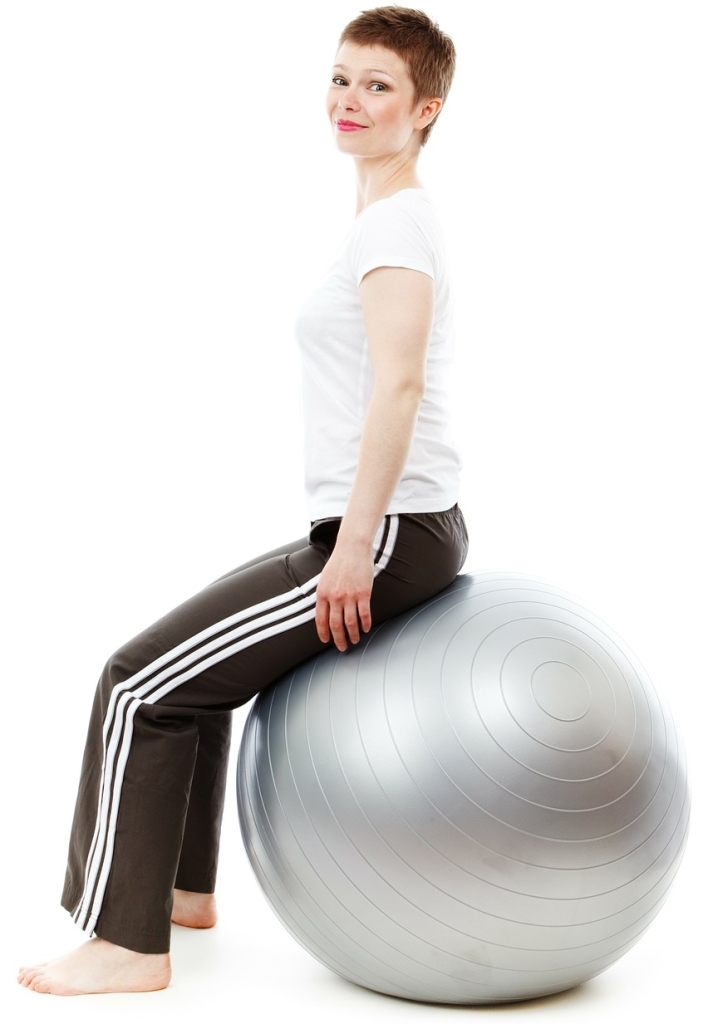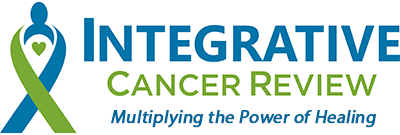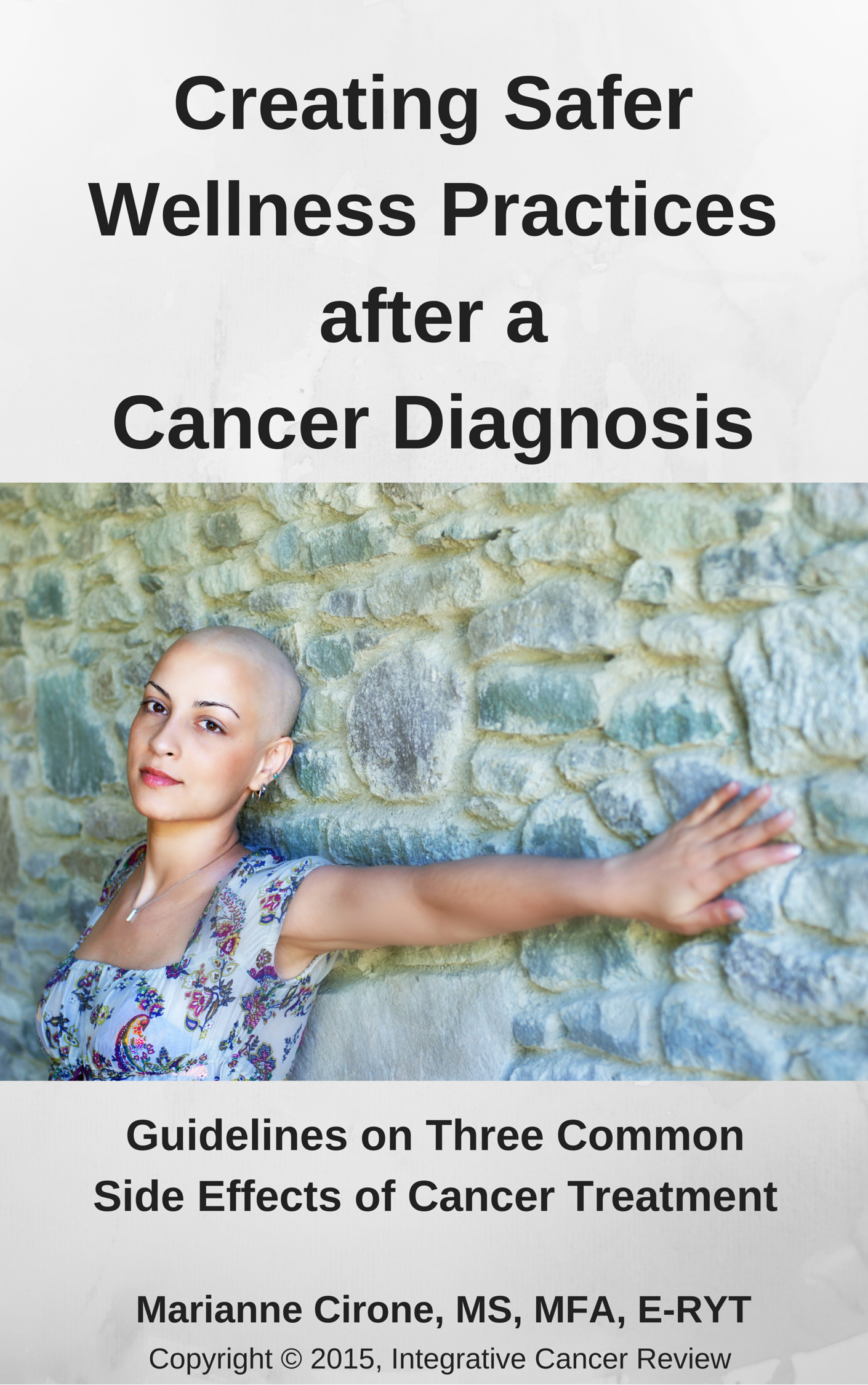
Julie, age 44, finished treatment for Stage 2 breast cancer and her chemotherapy treatments threw her into instant menopause. Her doctor mentioned the possibility of bone weakening as a side effect of treatment, but she thought that since she was still young and active it would be fine to start attending high intensity yoga classes at the local yoga studio without any modifications.
Karl, age 64, was diagnosed with prostate cancer at age 59 and had been on androgen deprivation therapy to reduce his testosterone levels and decrease the aggressiveness of the cancer. He slipped on the ice and fractured two ribs a year ago but felt better and wanted to start taking fitness classes at the local health club to improve his strength and flexibility.
Both Julie and Karl may be at risk for serious bone loss conditions like osteopenia or the more severe condition, osteoporosis, which can lead to fractures.
While movement practices, whether fitness programs or yoga classes, have many benefits, those at risk for bone weakening conditions should be aware of important precautions to reduce their of injury.
How Prevalent are Bone Loss Conditions?
According to a 2012 report by the Centers for Disease Control, approximately half of people in the general population aged 50 and over, men and women included, have osteoporosis or osteopenia.
The percentage with bone loss increases with age–with women in their 60s and 70s experiencing rates of osteopenia or osteoporosis between 75% and 95%.
The prevalence of bone loss in those who have been diagnosed with cancer may be even higher due to the potentially negative impact of cancer and cancer treatment on bone health.
Of the population with bone loss, researchers indicate that an “alarming large” percentage of people have not been tested and officially diagnosed with this conditions.
It is important that people at risk for bone loss talk to their physicians about getting tested for bone loss, but this all means that extra precaution should be taken for those in high risk categories, even without an “official” diagnosis.
What People with Bone Loss Need to Know about Exercise and Yoga
Individuals with bone loss can minimize their risk of injury by taking some important precautions. Wellness professionals should know about the potential for osteopenia and osteoporosis to exist in their client populations and adapt their programs accordingly.
The warnings about movements for people with osteoporosis are clear.
The National Osteoporosis Foundation states, “If you have osteoporosis, you need to remember an important rule when exercising or going about your daily activities:
Do not flex or bend your spine forward.
Backward bending or leaning back, however, reduces stress on the front of the spine.”
So, how do we use this information to make our practices safer and to adapt for people at risk for bone loss conditions?
Spinal Flexion and Vertebral Fractures
Spinal flexion, also known as forward bends, can lead to spinal fractures called vertebral compression or wedge fractures. This is because the anterior, or front, of the vertebrae is the weakest part of the structure, making it vulnerable to compression fractures and increased pressure on the vertebral disks. The danger of spinal fractures is that a single fracture increases thoracic kyphosis and the risk of subsequent fractures.
People should not be deterred from practicing yoga or performing other exercises that are done appropriately and safely for bone loss conditions. If done safely, these practices may actually benefit bone health and provide many other benefits as well.
Can Yoga Benefit Bones?
Loren Fishman, MD, a rehabilitation physician and Iyengar yoga teacher, and co-author with Ellen Saltonstall of the book, Yoga for Osteoporosis, states that yoga—practiced appropriately—can safely stress bones and causes new bone formation, while also exerting a positive effect on joints, unlike forms of higher impact movement that may stress joints.
Dr. Fishman conducted research on twelve yoga poses, performing bone density testing on subjects with osteoporosis, osteopenia and normal bones.
Each group had a DEXA scan taken before and after two years of practicing yoga for just ten minutes a day, with following results:
- The three yoga groups all showed a dramatic rise in bone density.
- A control group of subjects who did not practice yoga saw a modest fall in bone mineral density.
Modifying or Avoiding Forward Bends
Even with significant modifications on the classical yoga poses that Dr. Fishman used for the students in his study with osteoporosis or osteopenia, Dr. Fishman eliminated the riskiest category of poses for vertebral fractures—forward bends—from the poses he included in his study protocol. However, Dr. Fishman states that the avoidance of forward bends “can be carried to phobic extremes.”
So, what is the best course of action? To answer this, we first need to understand the relationship of forward bends and vertebral fractures.
What is the Evidence Regarding Yoga and Osteoporosis?
In a comprehensive 2013 study published in the International Journal of Yoga Therapy by Eva Norlyk Smith, PhD and Anita Boser, the authors reviewed all major studies related to osteoporosis, vertebral fractures and spinal movement from 1966 to 2011. Until the mid-1980s, the researchers noted, spinal flexion was actually recommended as treatment for the pain of spinal fractures. However, a 1984 study by Sinaki and Mikkelsen changed that thinking completely.
Sinaki and Mikkelsen divided 59 women with osteoporosis into four groups of practice and analyzed the results, which were dramatic.
The group practicing spinal flexion (forward bending) only had the highest rate of new spinal fractures, an astounding 89%–compared with only 16% in the spinal extension (back bending) only group, as shown below:
Sinaki & Mikkelsen, 1984
Yoga and Women with Osteoporosis
| Type of Movement Practiced | New Fractures |
|---|---|
| Spinal Flexion only (forward bending) | 89% |
| No exercise, just heat and massage | 67% |
| Combined spinal extension and flexion | 53% |
| Spinal Extension only (back bending) | 16% |
How Safe are Backbends?
Backbends should still be approached cautiously, say the experts, and you should avoid overarching the back. Fishman and Saltonstall suggest supine supported back bends, for example, using a rolled towel under the back, to help to restore normal posture.
Norlyk Smith and Boser found that back bends and movements that strengthen the spinal extensor muscles helps to retain healthy posture and normal spinal curves and reduce the risk of excessive thoracic kyphosis (rounding of the spine). Strengthening the back extensors reduces the risk of fracture, improves range of motion and may help provide a higher quality of life, regardless of bone density.
One of the 1984 study’s researchers, Mehrsheed Sinaki, M.D., of the Mayo Clinic, leads osteoporosis-related research and programs targeted at strengthening back muscles for the reduction of kyphosis, vertebral fractures and fall risk.
Can Poor Posture Lead to Fracture Risk?
A postural misalignment such as thoracic hyperkyphosis can actually lead to an increased risk of fracture. In fact, as the degree of kyphosis is increased, the compressive stress on the front of the vertebrae is magnified. Independent of bone density issues, hyperkyphosis is associated with an increased risk of fractures of the hip and vertebrae, reduced breath capacity and increased mortality. It is definitely a condition that we want to take active steps to prevent.
Safe Alignment in Forward Bends
There should be a distinction between forward bending that involves rounding of the spine (which is to be avoided) and a forward movement of the spine, called forward folding, in which the spine is NOT rounded, but instead remains long and relatively straight, where the forward movement comes primarily from hip flexion.
It is important to note that many forward bending poses, when done in a safe and stabilizing manner, involve an anterior (forward) rotation of the pelvis and a spinal alignment that looks more like an extension (back bend).
However, many yoga practitioners, unless they are relatively experienced and/or flexible, lack this alignment, particularly in seated forward bends. This results in unsafely rounding the spine and can particularly be seen in straight leg poses, such as Paschimottanasana (seated forward fold with legs extended straight out and the upper body moving toward the legs).
An exaggerated kyphotic position could put the yoga practitioner with bone loss at risk for compression fractures, while a forward fold done with spinal extension, would be safer.
Judith Hanson Lasater, PhD—an Iyengar yoga master teacher, physical therapist, and author of Yogabody: Anatomy, Kinesiology and Asana–states that she doesn’t teach Paschimottanasana, “the hardest forward bend” to beginners because “they don’t know how to tip their pelvis forward.”
Teachers of yoga classes for people affected by cancer are likely to find that many of their students are brand new to yoga, or haven’t practiced it in a long time, so this wisdom would apply to most of these teachers. In addition for the risk to the vertebrae, Lasater notes that a forward bend without an anterior tilt of the pelvis can also increase risk of damaging the intervertebral discs.
Safer Alternatives to Seated Forward Bends
There are, however, excellent substitutes for seated forward bends. A supine hamstring opening pose, such as supta padangustasana, shown below, is a great substitute for seated forward bends– which Loren Fishman calls “as safe and as good as a pose gets.”
Lasater suggests doing pelvic tilts in a table pose (hands and knees position) where sitting bones life in order to help students learn the action of tilting the pelvis forward. Lasater also recommends a parsvottanasana (pyramid pose) with hands upward on a wall or pole, as opposed to on the floor, and the ball of the front foot on a block to lengthen the hamstrings and calf muscles.
What about Twists?
Research shows that axial rotation of the spine–twisting–can increase risk for disc injury, particularly when combined with lifting a weight. And the action of swinging a golf club has also been linked to increased vertebral fractures.
However, according to several studies, there is no correlation between twisting in yoga poses and vertebral fractures. Loren Fishman, MD, has studied 500 participants with over 60,000 cumulative hours of yoga practice that included three gentle twisting poses– with no vertebral fractures reported.
In fact, Fishman and his co-author, Ellen Saltonstall, attribute the relative safety of twists to their symmetrical pressure to the vertebral body. They recommend gentle spinal twists as an important contributor to spinal health, as long as the spine elongates during the posture and gravity or leverage are not used. That means no “twisted root,” a supine twist with legs intertwined, or “bound” poses in which the arms are used and hands are clasped in order to deepen the twist. Twisting and lifting at the same time is definitely not advised.
In her book, Yoga for Better Bones, Margaret Martin, PT, CSCS, advises against deep rotation or using the arms or legs as levers, as in bound poses, but instead only taking the twist as far as the muscles allow. She also advises to avoid seated twists, as the combination magnifies the compressive and torque forces on the spine, although Fishman and Saltonstall do offer some seated twists in their book.
Norlyk Smith and Boser point out that twists are often advised against for by health professionals working with osteoporosis, but it would seem unnecessarily so. They recommend using “a considerable degree of caution” in axial rotation, but that spinal movement is necessary for the health of the spine.
Open twists (as opposed to closed twists that involve crossing over the body), typically work better for most students in terms of being able to keep the spine elongated, so there is less tendency to exaggerate thoracic kyphosis and endanger the vertebrae. In addition, closed tend to rely more on the leverage of the crossed arm to deepen the pose, which would be contraindicated for osteoporosis.
And Lateral Bends?
Norlyk Smith and Boser found that little empirical evidence exists for or against lateral bends with osteoporosis. For lateral bends, Martin suggests focusing on lengthening the spine and then keeping the lateral movement smaller as opposed to compressing the vertebrae with a deeper lateral fold.
Risk vs. Reward in Yoga and Exercise
Exercise needs to be appropriate to the individual and using excessive caution can be detrimental. Norlyk Smith and Boser state: “Exercise modifications suitable for high-risk individuals may be counterproductive for those at low risk for vertebral fractures.”
So, those at low risk should continue to practice in a way that is as vigorous as is safe for them.
However, Norlyk Smith and Boser do say, “Those with marked hyperkyphosis who are unable to perform flexion poses with a straight spine should be considered high risk for vertebral fractures” and should perform supine (reclining), non-weight bearing movements of the spine.
More Information
To see Dr. Fishman’s study results, including instructions for the 12 poses, modified for the three levels of participant bone health, see http://www.sciatica.org/yoga/12poses.html.
The information and discussions expressed on Integrative Cancer Review are for the purpose of sharing opinions and viewpoints and are not a substitute for seeking medical advice or care from your own doctor and health care professionals. No single pose or practice is safe for all people at all times, so consult with the appropriate professionals before developing a practice plan.













